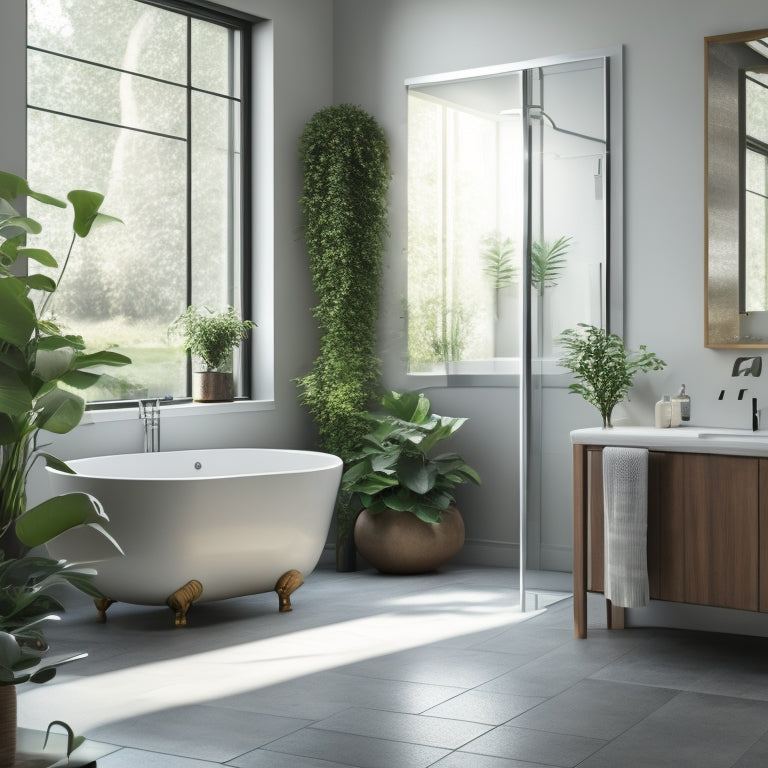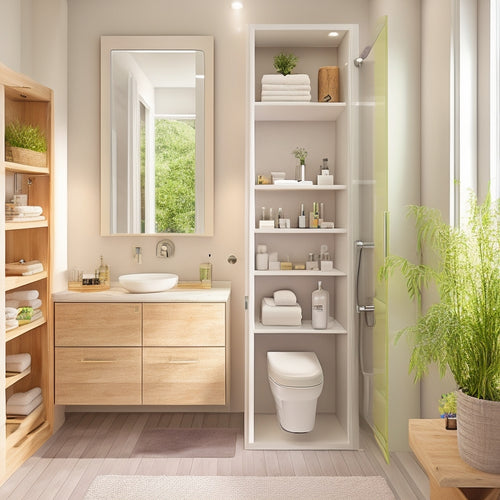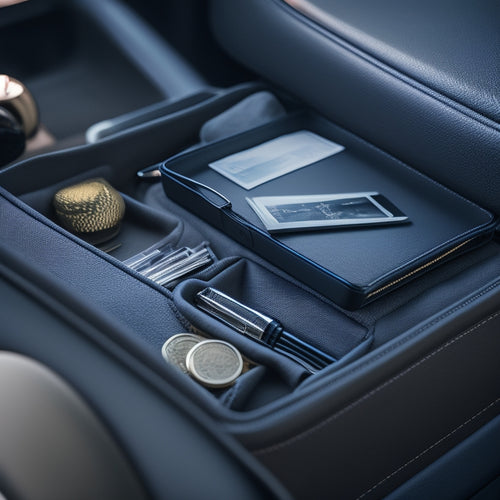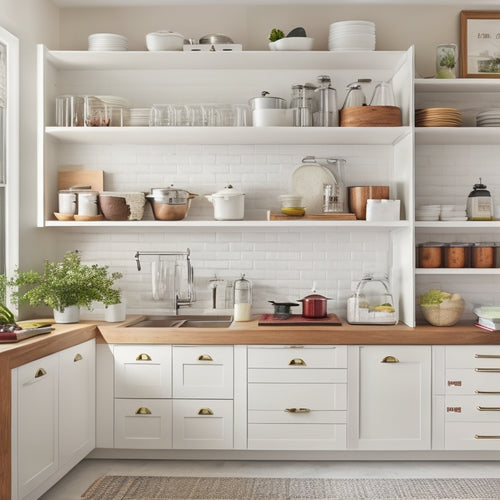
Pros and Cons of a Freestanding Tub
Share
You're assessing the pros and cons of a freestanding tub, and it's crucial to evaluate the visual appeal, installation requirements, space constraints, comfort benefits, and budget implications. A freestanding tub enhances your bathroom's aesthetic with sleek designs and various material options, but it demands careful installation planning and regular maintenance. With proper placement, it can provide a tranquil and relaxing experience. However, the cost can be steep, ranging from $1,000 to $5,000, depending on the material and features. As you investigate the world of freestanding tubs, you'll uncover more subtleties that can make or break your decision.
Key Takeaways
- Freestanding tubs offer sleek, modern designs and unique aesthetics, enhancing bathroom visual appeal and creating a spa-like atmosphere.
- Installation requires careful planning, verification of plumbing system capacity, and surface protection to maintain the tub's glossy finish.
- Freestanding tubs provide a luxurious soaking experience, promoting relaxation and rejuvenation, but require a spacious setting and careful layout consideration.
- Higher upfront costs, ranging from $1,000 to $5,000, and additional installation costs may deter some homeowners, but can increase home resale value.
- Regular cleaning and maintenance are necessary to avoid material damage and scratches, but the benefits of a freestanding tub can outweigh the extra effort.
Visual Appeal and Aesthetic
With its sleek, modern design, a freestanding tub instantly boosts the visual appeal of your bathroom. You'll love how it becomes a focal point, drawing attention to its curves and lines.
The design styles of freestanding tubs vary, ranging from minimalist to ornate, so you're sure to find one that fits your unique taste. Material choices are also abundant, with options like acrylic, solid surface, and even copper or stone. Each material offers its own distinct look and feel, allowing you to customize the aesthetic of your bathroom.
When choosing a freestanding tub, consider the overall vibe you want to create in your bathroom. Do you prefer a spa-like ambiance or a more modern, edgy look? Your tub can help set the tone, and with the right design and material, it can be a stunning centerpiece.
Plus, the lack of surrounding walls or enclosures means you can appreciate the tub's beauty from all angles. Whether you're going for sleek and modern or luxurious and ornate, a freestanding tub is sure to enhance the visual appeal of your bathroom.
Installation and Maintenance Needs
As you're drawn to the visual appeal of a freestanding tub, it's important to reflect on the logistics of bringing this stunning centerpiece into your bathroom. Installation requires careful planning, especially when it comes to plumbing requirements.
You'll need to verify that your bathroom's plumbing system can support the tub's water capacity and drainage needs. This might involve reconfiguring pipes or installing new fixtures, which can add to the overall cost.
Once installed, you'll need to take into account surface protection to maintain the tub's glossy finish. Regular cleaning with gentle products is a must, as harsh chemicals can damage the material.
You may also want to apply a protective coating to prevent scratches and water spots. Additionally, be prepared for more frequent cleaning around the tub's base, as dirt and grime can accumulate in the space between the tub and the floor.
Space and Layout Considerations
Position the freestanding tub thoughtfully, as its grandeur demands a spacious setting. You'll want to contemplate the room dimensions and placement options to guarantee a harmonious coexistence with the surrounding space.
A freestanding tub typically requires at least 12 square feet of floor space, but this can vary depending on the tub's size and shape. Measure your bathroom carefully to determine the best placement, factoring in the distance from the walls, doors, and any other fixtures.
You might need to adjust the layout of your bathroom to accommodate the tub, which could involve relocating plumbing, electrical outlets, or even rearranging the entire room.
Think about the flow of traffic in your bathroom, too. You'll want to confirm that the tub doesn't obstruct the path to other essential areas, like the shower or sink.
Comfort and Relaxation Benefits
Once you've carefully planned the layout of your bathroom to accommodate a freestanding tub, you can focus on the luxurious experience it provides.
The ergonomic design of these tubs guarantees that you'll be pampered in comfort, with contoured seats and backrests that cradle your body. As you sink into the warm water, you'll appreciate the thought that's gone into creating a spa-like experience in your own home.
Freestanding tubs are designed to retain temperature, keeping the water warm for a longer period. This means you can indulge in a relaxing soak without worrying about the water cooling down too quickly.
The insulation and thermal properties of these tubs work together to maintain the perfect temperature, allowing you to unwind and rejuvenate. With a freestanding tub, you'll be treated to a tranquil experience that will leave you feeling refreshed and revitalized.
Cost and Budget Implications
Your budget is likely to take a hit with the installation of a freestanding tub, as these luxurious fixtures come with a higher price tag compared to traditional built-in tubs.
On average, you can expect to pay between $1,000 to $5,000 or more for a high-quality freestanding tub, depending on the material, size, and features.
In addition to the tub itself, you'll also need to factor in the cost of installation, which can range from $1,000 to $3,000, depending on the complexity of the job and the plumber's rates.
Here are some key cost considerations to keep in mind:
- Freestanding tubs often require additional plumbing and flooring modifications, adding to the overall cost.
- High-end materials like copper or stone can greatly increase the price of the tub.
- Custom or bespoke designs can also drive up the cost of the tub and installation.
- While freestanding tubs may be a long-term investment, they can also increase the resale value of your home.
While the upfront cost may seem steep, consider the long-term benefits of a freestanding tub as a worthwhile investment in your home's value and your own relaxation and comfort.
Frequently Asked Questions
Can a Freestanding Tub Be Installed on a Second Floor?
You're wondering if you can install a freestanding tub on your second floor; well, it's doable, but you'll need to take into account weight requirements and verify your floor can handle the load, plus factoring in installation considerations like plumbing and support.
Are Freestanding Tubs Suitable for People With Mobility Issues?
As you step into your serene oasis, you'll want to guarantee it's accessible; freestanding tubs can be a hurdle for people with mobility issues, but with clever accessibility features and safety modifications, like grab bars and non-slip mats, you'll be soaking in comfort in no time.
Can I Use a Freestanding Tub With a Converted Shower Area?
You can totally rock a freestanding tub with a converted shower area, but be prepared to sacrifice some aesthetics for functionality. Plus, you'll need to factor in slightly more maintenance to guarantee water doesn't seep behind the tub.
Do Freestanding Tubs Require Special Cleaning Products?
You'll be relieved to know that freestanding tubs don't require special cleaning products, but you'll still need to perfect gentle cleaning techniques and maintenance tips to keep them sparkling, like avoiding abrasive materials and using a microfiber cloth.
Are Freestanding Tubs Compatible With All Types of Flooring?
When you're installing a freestanding tub, you'll need to take into account the flooring's durability and style; weight distribution is key, so verify your floor can handle the tub's weight and water's added pressure, or you'll be stuck with a flooded mess!
Conclusion
You've weighed the pros and cons of a freestanding tub, and now it's time to make a decision. If you're worried that the extra space required will make your bathroom feel cramped, consider a wall-mounted vanity or a pedestal sink to create the illusion of more floor space. With careful planning, a freestanding tub can be a stunning centerpiece that enhances your bathroom's style and functionality.
Related Posts
-

Modular Bathroom Storage for Small Spaces
Modular bathroom storage is your go-to solution for small spaces, turning clutter into chic organization. Use wall-mo...
-

High Road Car Glove Box Organizer Review
The High Road Car Glove Box Organizer is a top-rated solution for keeping vehicle documents and essentials neatly org...
-

Revolutionize Your Kitchen With Shelfgenie Installation
I'm on a mission to revolutionize my kitchen with Shelfgenie installation, and I'm loving the results! With a seamles...


